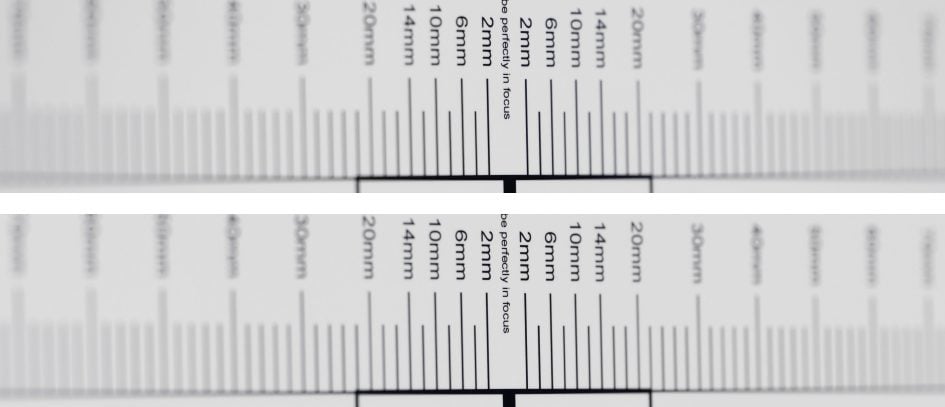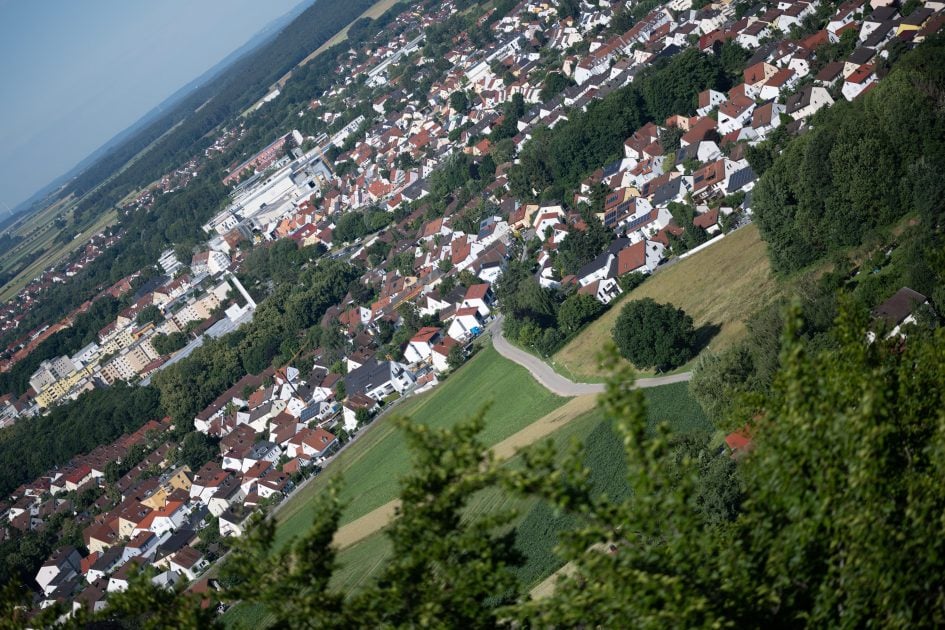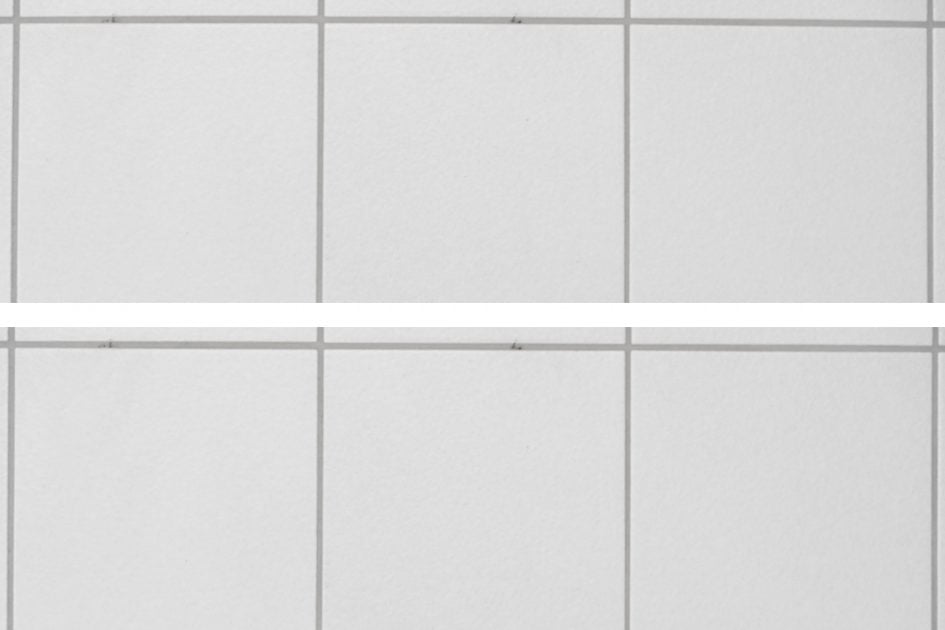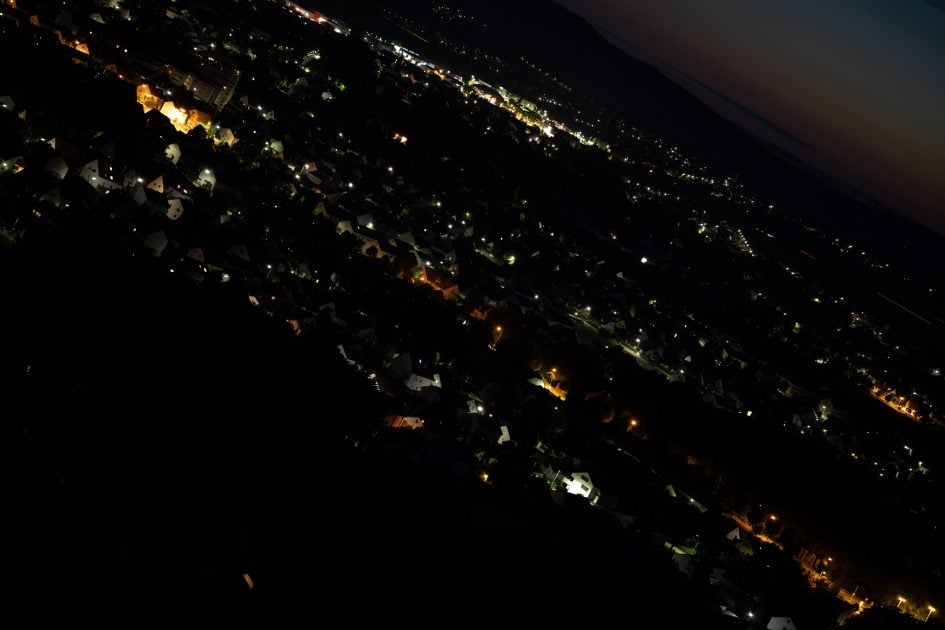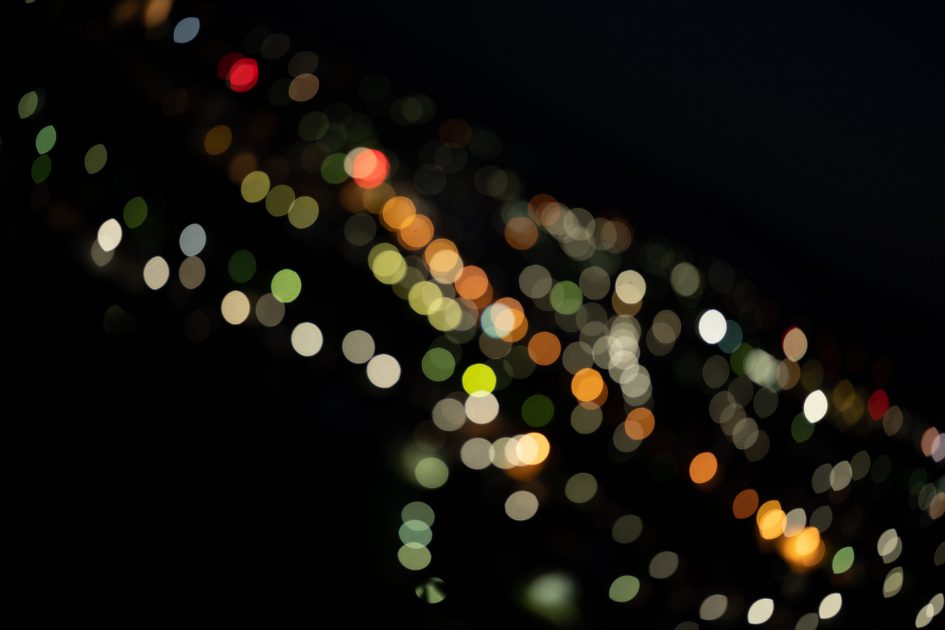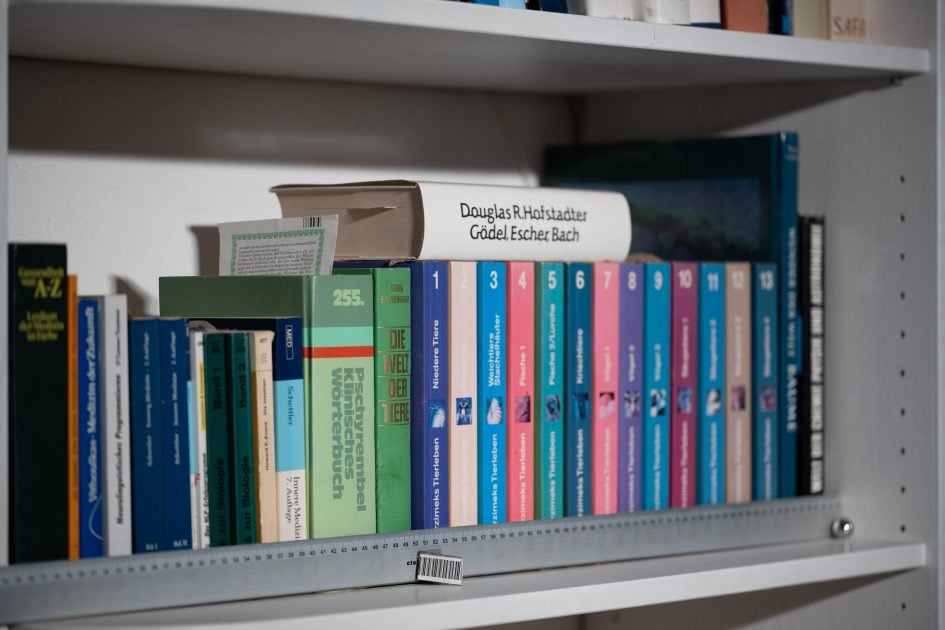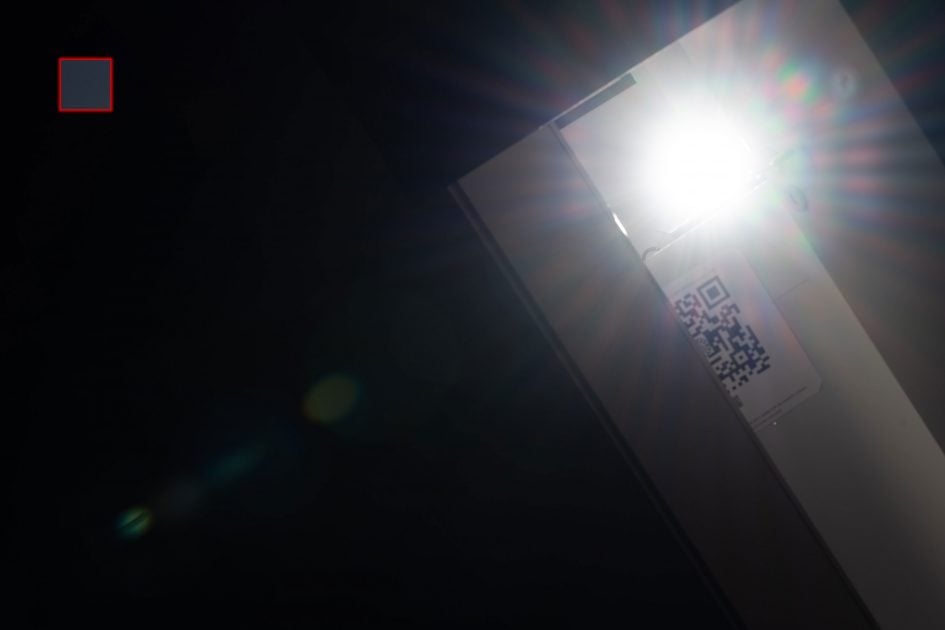Nikon Z MC 105mm f2.8 VR S review
-
-
Written by Thomas
Quality
Testing: Longitudinal Chromatic Aberration and focus shift
Lenses with focal ratios of f2.8 or larger are often prone to longitudinal color aberrations (loCA, a.k.a. “axial color” or “bokeh CA”). These show up as magenta coloration in the foreground and greenish hues in the background and are not easily corrected in post-processing. The Nikon Z MC 105mm f2.8 VR S shows only a bit of loCA at normal distances and it does not become stronger when closing in. Focus shift is hardly discernible.
Nikon Z MC 105mm f2.8 VR S longitudinal Chromatic Aberration (loCA)
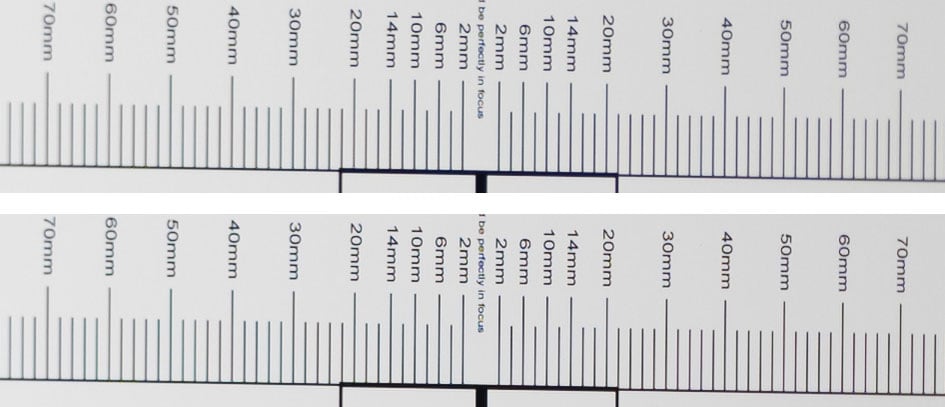
Above: Shot at 4m distance, f2.8 (top), f4.0 (bottom); 100% crops, left = foreground, right = background
Above: Shot at 1m distance, f3.0 (top), f4.0 (bottom); 25% crops, left = foreground, right = background; click image for 100% crop
The following shot shows that the Nikon Z MC 105mm f2.8 VR S produces no purple fringing around high-contrast edges in the focus plane or color aberrations around specular highlights:
Above: Nikon Z MC 105mm f2.8 VR S at f4.0, 1:1.5; 100% crop, click image for 4k version, here for large original
Sharpness and contrast
Let’s have a look at the theoretical performance of the Nikon Z MC 105mm f2.8 VR S first and compare it to the Laowa 100mm f2.8 2x Macro APO and Sigma 105mm f2.8 DG DN Macro Art:
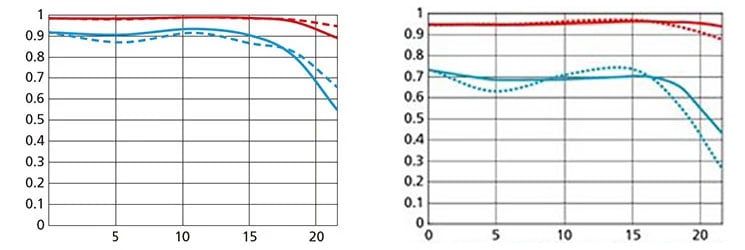
Above: Nikon Z MC 105mm f2.8 VR S (left), Nikon Micro 105mm f2.8G VR
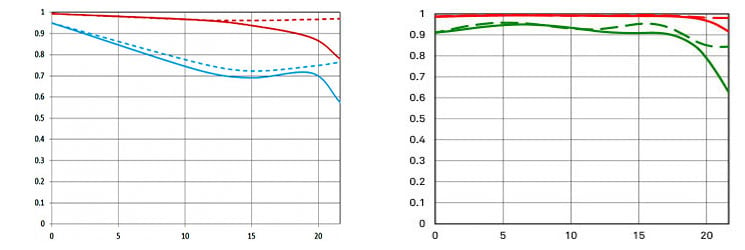
Above: Laowa 100mm f2.8 2x Macro APO (left), Sigma 105mm f2.8 DG DN Macro Art (right)
These MTF charts show the computed lens-performance of lenses wide open at infinity without influence of diffraction at 10 line-pairs/mm (red) and 30 lp/mm (blue/green). Higher values are better (more contrast) and the closer the dotted and solid lines are together the less contrast dependents on the orientation of the test-pattern (less astigmatism). The x-axis displays the distance from the optical axis (=center of the sensor) in mm. I’ll show you the real-life performance at 4 mm (“center”), 13 mm (APS-C/DX-corner), and 20 mm (FF/FX-corner) on a on a 45MP Nikon Z7 camera.
From the charts the new Z-Nikkor should be clearly sharper than its predecessor and also sharper than the Laowa (at infinity). Only the Sigma looks even a bit better on paper.
Let’s see how this theoretical performance translates into real life results in the sharpness test based on Siemens-stars. Shooting distance was 45x focal length i.e. at around 5m. Processing was done in Lightroom 10.3/CRAW 13.3 from RAW to Adobe Color profile with the built-in lens profile compensating CA, vignetting, and distortions. Noise-reduction is set to 0, sharpening to 50/0.5/36/10, with no extra tone, color, or saturation adjustment. White-balance was adjusted to a neutral white and I did some exposure compensation to make the brightness of all crops match. So you will not see light fall-off in the corners.
The following 100% crops show the Nikon Z MC 105mm f2.8 VR S from f2.8 down to f11 compared to the Laowa 100mm f2.8 2x Macro APO and Sigma 105mm f2.8 DG DN Macro Art at f2.8. The Sigma was shot on a Sony A7R II. With linear resolution of the 45MP Z7 sensor only 4% higher than from the 42MP A7R II, identical test set-up, and identical RAW processing, comparability between the test-shots should be very good. Keep in mind though that although I used uncompressed 14 bit RAW files Nikon and Sony probably process their sensor data differently to create their RAW files.
Nikon Z MC 105mm f2.8 VR S compared; 100% crop from center, DX-corner, FX-corner

Above: Nikon Z MC 105mm f2.8 VR S at f2.8

Above: Laowa 100mm f2.8 2x Macro APO at f2.8

Above: Sigma 105mm f2.8 DG DN Macro Art on a Sony A7R II at f2.8

Above: Nikon Z MC 105mm f2.8 VR S at f4.0

Above: Nikon Z MC 105mm f2.8 VR S at f5.6; also available at f8.0, f11
At f2.8 the Nikon Z MC 105mm f2.8 VR S is clearly sharper than the Laowa and almost matches the Sigma. Stopping the Z-Nikkor down to f4.0 improves acuity slightly. The test also showed the Nikon to have practically no field-curvature at this distance. Overall the lens delivers very good sharpness across the full frame sensor.
Performance at long distances
As performance of lenses also depends on the shooting distance I present another series of test-shots of a city around 1 km away. Processing was done in Lightroom 10.3/CRAW 13.3 from RAW to Adobe Color profile with the built-in lens profile compensating CA, vignetting, and distortions. The Sigma was corrected for CA and vignetting. The Laowa had CA compensation switched on and some Vignette compensation manually applied. Noise-reduction is set to 0, sharpening to 50/0.5/36/10, with no extra tone, color, or saturation adjustment. I used manual focus at the largest aperture and did not change focus for other apertures.
The following image shows the complete scene wide open to give you an impression of the angle of view. Following the main image are 100% crops from the center, DX-corner, and FX-corner from the Nikon Z MC 105mm f2.8 VR S compared to the Laowa 100mm f2.8 2x Macro APO and Sigma 105mm f2.8 DG DN Macro Art (shot on a Sony A7R II) at f2.8. The Sony and Sigma were shot at other days under a bit less clear atmospheric conditions. As usual I have selected the diagonal that provided the better corner results as almost any lens is a bit decentered.
You can access the large originals but please respect our copyright and only use those images for personal use.
Above: Nikon Z MC 105mm f2.8 VR S at f2.8
Above: Nikon Z MC 105mm f2.8 VR S at f2.8; 100% crops, click image for 4k version, here for large original
Above: Laowa 100mm f2.8 2x Macro APO at f2.8; 100% crops, click image for 4k version, here for large original
Above: Sigma 105mm f2.8 DG DN Macro Art on a Sony A7R II at f2.8; 100% crops, click image for 4k version, here for large original

Above: Nikon Z MC 105mm f2.8 VR S at f4.0

Above: Nikon Z MC 105mm f2.8 VR S at f5.6; also available at f8.0, f11
Again, the 100% crops of the Nikon Z MC 105mm f2.8 VR S look very sharp across the full frame sensor, comparable to the Sigma and clearly sharper outside the center than the Laowa. The Z-Nikkor is so sharp indeed that stopping down does not gain much.
Vignetting and distortions
To make it easier to see light fall-off in the corners of a full-frame sensor I’ve arranged a series of three shots each with the new Z-Nikkor from f2.8 to f5.6 and focused to infinity. All images were developed to the same brightness in the center and are shown with vignette control Off (1st row) resp. Normal (2nd row):
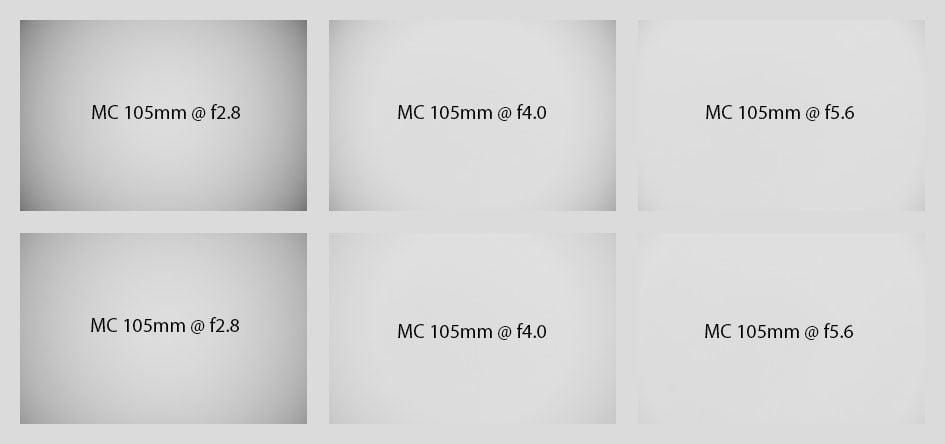
Above: Nikon Z MC 105mm f2.8 VR S at infinity without vignette compensation (top) / vignette compensation set to Normal (bottom)
The sample images above show that with the lens profile applied vignetting is OK at f2.8. From f4.0 onwards there is nothing to worry about. At f2.8 automatic shading compensation lifts the extreme corners about 0.5-0.6 EV which is pretty moderate. I didn’t test Vignette control at “high” which should give the corners a stronger lift. As is typical with most lenses, vignetting is reduced when focusing closer. Even without any vignette compensation and wide open it is not a problem at macro shots.
Adobe’s RAW converter automatically applies Vignette control as it was set in camera – but you cannot alter the setting in postprocessing. That’s different with distortions: Adobe’s RAW converter ignores what was set in camera and always corrects them. So I had to do the following comparison with JPGs straight out of camera. Distortions are of a mild pin-cushion type at 2m distance and are well-corrected by the lens profile:
Distortions: Nikon Z MC 105mm f2.8 VR S, as is (top) / with distortion compensation On (bottom)
The lens profile also works very well in close-up shots as you can see in this 1:1 macro shot.
Rendering of point-light sources at night-shots
Night-shots pose a different challenge for lenses as the contrast is even higher than under bright sun and point-light sources can reveal some weaknesses such as coma, haloing and colour-aberrations that do not show up as prominently in other test-shots. The 100% crops below the main image show the effect of coma in the FF-corner of the Nikon Z MC 105mm f2.8 VR S at different apertures:
Above: Nikon Z MC 105mm f2.8 VR S at f2.8; click image for 4k version, here for large original

Above: Nikon Z MC 105mm f2.8 VR S; 100% crops from the FX-corner at f2.8 (left), f4.0 (middle), f5.6 (right)
The Nikon Z MC 105mm f2.8 VR S produces very little coma even wide open. The test also shows no color artifacts around bright streetlights.
Bokeh quality
This test is for the rendering of point-light sources in an out-of-focus background. The circle of confusion that is produced by this test is pretty indicative of Bokeh performance (in the background) and light fall-off. Ideally the out-of-focus image of the point-light is evenly lit and perfectly circular, with no “onion-rings”, and without coloration. Large aperture lenses normally produce an effect known as “cat’s eye” the further away from the optical axis the point-light is projected. This is due to optical vignetting in the lens barrel when light enters the lens from an angle.
The crops below the main image are from the center, DX-corner, and FX-corner resized to make them comparable across all my reviews.
Above: Nikon Z MC 105mm f2.8 VR S at f2.8; click image for 4k version
Above: Nikon Z MC 105mm f2.8 VR S at f2.8; click image for 100% crop
Above: Nikon Z MC 105mm f2.8 VR S at f4.0; click image for 100% crop
Above: Nikon Z MC 105mm f2.8 VR S at f5.6; click image for 100% crop
The diameter of the Bokeh balls in the center is determined by the entrance pupil of the lens. So the Z-Nikkor produces Bokeh balls at f2.8 as large as from a 50mm lens at f1.4. Compression of the circle towards the corners is stronger than from the Sigma at f2.8 but is gone at the DX-corner at f5.6. The circle of confusion in the center is not perfectly round even wide open. This is the consequence of the aperture protruding slightly into the lens barrel even at f2.8. The inside of the Bokeh balls is pretty smooth but there is some outlining.
Let’s see how this analysis of out-of-focus point-light sources translates into Bokeh-performance shooting a book-shelf. Crops are from the foreground, middle-ground, and background resized to make them comparable across all my reviews.
Above: Nikon Z MC 105mm f2.8 VR S at f2.8
Above: Nikon Z MC 105mm f2.8 VR S at f2.8; click image for 4k version, here for large original
Above: Laowa 100mm f2.8 2x Macro APO at f2.8; click image for 4k version, here for large original
Above: Sigma 105mm f2.8 DG DN Macro Art on a Sony A7R II at f2.8; click image for 4k version, here for large original
All three lenses look pretty similar in the crops above with the Sigma seeming a bit less soft in the foreground and middle-ground. They also show no greenish tinge from loCA in the middle-ground.
Looking at another crop (now at 100%) from the same images showing the ruler reveals the Z-Nikkor rendering a bit smoother Bokeh with less double contours than the Laowa or Sigma.
Above: Nikon Z MC 105mm f2.8 VR S at f2.8; click image for 4k version, here for large original
Above: Laowa 100mm f2.8 2x Macro APO at f2.8; click image for 4k version, here for large original
Above: Sigma 105mm f2.8 DG DN Macro Art on a Sony A7R II at f2.8; click image for 4k version, here for large original
Close-up performance
The Nikon Z MC 105mm f2.8 VR S goes down to 1x magnification (1:1). The first set of images was shot at 1:3.6 magnification where the area of sharp focus is just 87 x 130mm. The crops shown below are from 4mm, 13mm, and 20mm off the center of the sensor respectively. For the following crops I focused once on the center wide open and did not change focus: Each row of crops is from the same shot, focused optimally for the center. So this is the best results you can get from a single shot as any issues with field curvature would show up here.
Nikon Z MC 105mm f2.8 VR S; 100% crop from center, DX-corner, FX-corner

Above: Nikon Z MC 105mm f2.8 VR S at f3.2 (effective), 1:3.6

Above: Nikon Z MC 105mm f2.8 VR S at f5.6 (effective), 1:3.6

Above: Nikon Z MC 105mm f2.8 VR S at f11 (effective), 1:3.6
The Nikon Z MC 105mm f2.8 VR S produces very sharp results right across the full frame sensor even wide open. Stopping down to f11 robs a bit of acuity due to diffraction. And there’s almost no field curvature.
The next set of images was shot from low ISO b&w film negativ at 1:1 magnification. So the “noise” that you see in the crops is actually the film grain. The crops shown below are from 0mm, 15mm, and 19mm off the center of the sensor respectively. The lens was focused specifically for each crop which eliminates the risk of a misaligned target or any residues of field curvature. So this is the best result you can get from focus stacking multiple shots with the Nikon lens.
Nikon Z MC 105mm f2.8 VR S; 100% crop from center, DX-corner, FX-corner
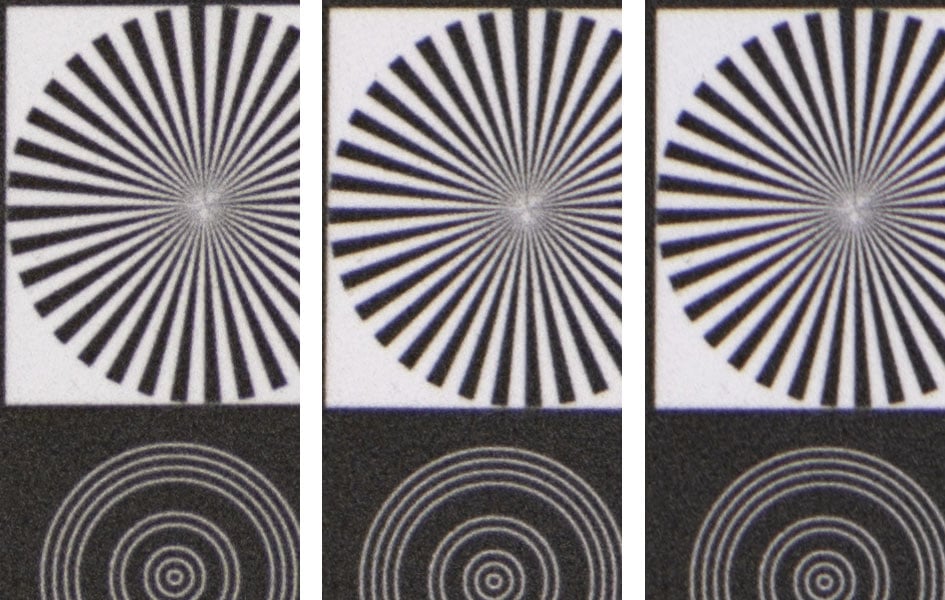
Above: Nikon Z MC 105mm f2.8 VR S at f4.5 (effective), 1:1
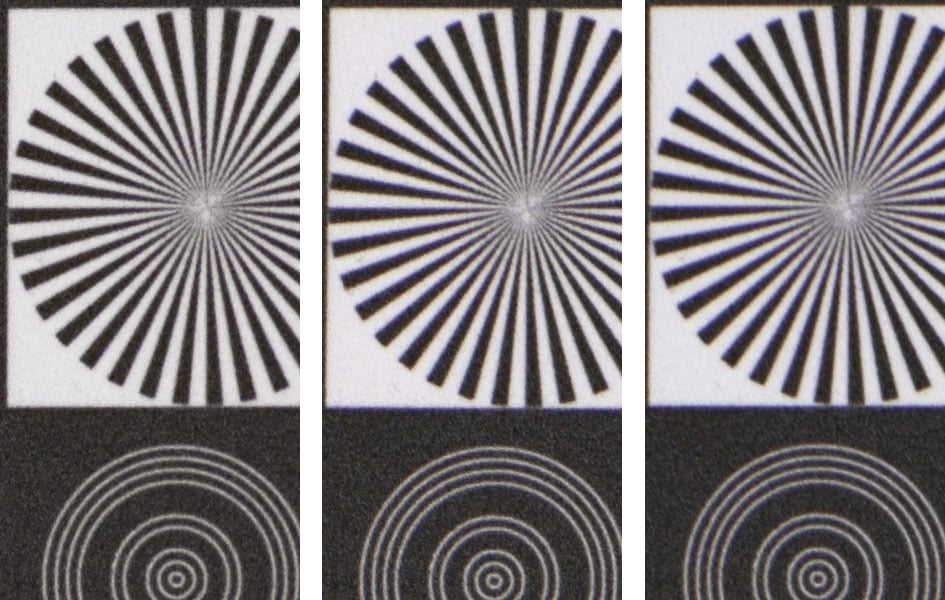
Above: Nikon Z MC 105mm f2.8 VR S at f5.6 (effective), 1:1
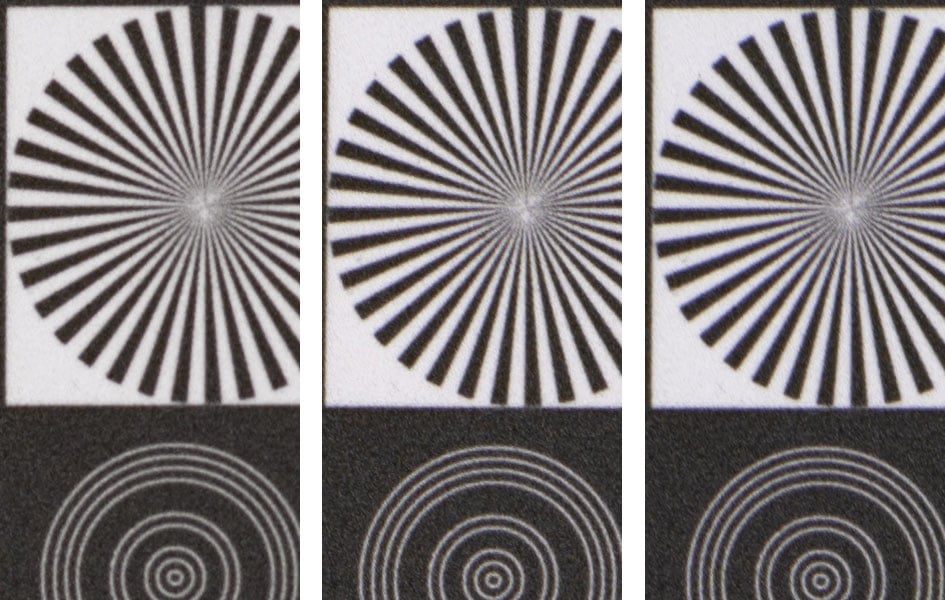
Above: Nikon Z MC 105mm f2.8 VR S at f8.0 (effective), 1:1
The Nikon Z MC 105mm f2.8 VR S produces sharp images with only a slight softening towards the FX-corner when used wide open. The corner profits from stopping down to f8.0.
A few observations from using focus shift shooting with the Nikon Z MC 105mm f2.8 VR S between 1:1 and 1:4 magnification:
- Focus on the nearest point you need to be sharp. Focus shift shooting takes the indicated number of shots focusing incrementally further away from this point.
- Focus step width (1-9) and effective aperture determine how far focus is changed between each shot. For sharpest results from focus stacking use a step width of 4 (values between 1 and 4 do not change the results). A value of 7 doubles the focus shift distance, a value of 10 doubles it again. So at 10 you only need a quarter of the shots that you need with 4. But then you’ll end up with a lower quality focus stack.
- If you stop the lens down depth-of-field increases and the camera automatically increases the focus shift distance accordingly – no need to change the focus step width. So you could capture the same focus range at f4.0 with 100 shots or f8.0 with 50 shots.
- When shooting at 1:1 magnification, a focus step width of 4, and an aperture of f4.5 the focus shift distance of the Z MC 105mm f2.8 VR S is 100 micron which is well within the depth of field. So even shooting with a focus step width of 7 (resulting in a focus shift distance of 200 micron) should be a safe step size for stacking, allowing for 20% image overlap.
- When the focus shift sequence is done, focus remains at the farthest point. Check the last image and if it is not far enough away simply start another focus shift sequence from that point. Should the lens hit infinity, focus shift shooting is automatically terminated and no shots wasted reaching “beyond the horizon”.
All in all focus shift shooting involves a bit of guesswork regarding the number of shots to cover the desired focus range. But after a bit of experimenting you can quickly and easily get perfect image sequences which you then can merge with the stacking software of your choice. For starters have a look at the stacked images on the next page: I’ve listed the number of steps I used to create the images. So you can get a feeling of what you might need at a focus step width of 4.
Flare, ghosting, and sun-stars
Catching a strong light-source shining directly into the lens is always a risky business: it could produce strange colorful ghost-images or reduce contrast considerably through flare and glare. The appearance of flare and ghosting depends on factors like the aperture and the angle of the light hitting the lens. So to judge the proclivity of Nikon’s Z MC 105mm f2.8 VR S for these artifacts I went through a series of well calculated shots against a strong light source to provoke glare and ghosting. The lens hood was mounted in all shots. Following is one of the more extreme example results. The little bright square inset in the upper left shows the respective area with an exposure compensation of +3 EV to make it easier to see which levels of black the lens renders at that point:
Above: Glare and ghosting from strong light hitting the Nikon Z MC 105mm f2.8 VR S at f11; click image for 4k version or here for +3 EV exposure compensation
The Nikon Z MC 105mm f2.8 VR S produces some weak ghosting artifacts and is not overly affected by veiling glare. This is much better than what the Laowa 100mm f2.8 2x Macro APO shows.
The lens produces sunstars even at f2.8. Stopping down does not necessarily make them more prominent: at f4.0 and f8 they are even fuzzier than at other aperture values.

Above: Sunstars from the Nikon Z MC 105mm f2.8 VR S from f2.8 (left) to f11 (right), 100% crops
Next check out my sample images!
Check prices on the Nikon Z MC 105mm f2.8 VR S at B&H, Adorama, WEX UK or Calumet.de. Alternatively get yourself a copy of my In Camera book or treat me to a coffee! Thanks!